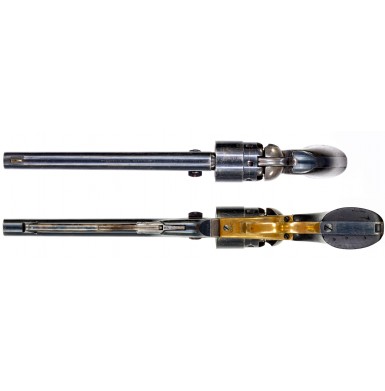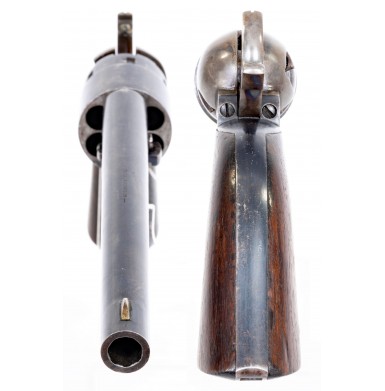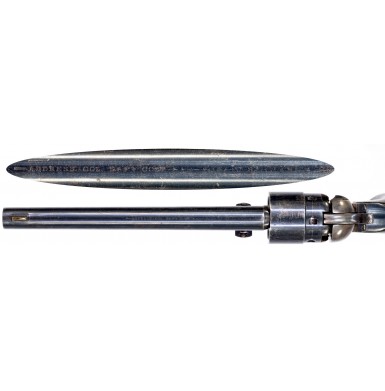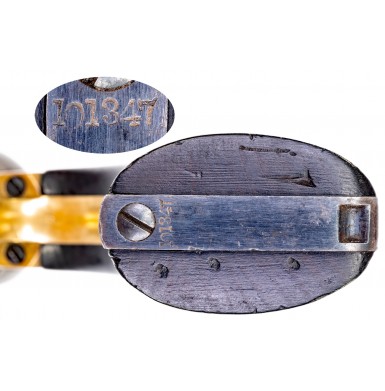Indian War Era US Arsenal Refurbished "C&R" Colt Model 1860 Army Revolver
- Product Code: FHG-3524-SOLD
- Availability: Out Of Stock
-
$4,250.00
There is probably no more iconic revolver from the American Civil War era than the US Model 1860 “New Model” Army Percussion Revolver, produced by the famous Colt Patent Firearms Company. More Colt “Army” .44 caliber revolvers were purchased by the US military during the course of the Civil War than any other model of handgun. Thousands of Model 1860 “Armies” that were sold commercially no doubt saw service in the field as well, in the hands of both northern and southern soldiers. The revolver was developed by Colt to provide a smaller, lighter, and more streamlined replacement for the .44 caliber “Dragoon” series of revolvers that had preceded it. The revolver essentially utilized the smaller Model 1851 “Navy” revolver frame, coupled with a slightly larger, iron backstrap, an 8” .44 caliber barrel and a rebated, 6-shot cylinder that allowed the .44 cylinder to fit on the .36 caliber frame. While some early production Model 1860 Army revolvers had non-standard features like 7 ½” barrels and fluted cylinders, these guns were produced in very limited quantities and are typically only encountered under serial number 5000 or so. Colt produced some 200,500 Army revolvers between 1860 and 1872, making it one of their most successful handgun designs of the 19th century. During the course of the American Civil War, the US Ordnance Department acquired some 127,157 Colt Model 1860 Army revolvers by direct contract with Colt. These guns were delivered between 1861 and 1863, with no deliveries in 1864 or 1865. Delivery totals for 1861 were 14,500, with 53,702 and 58,955 delivered in 1862 and 1863, respectively. An additional 2,027 Model 1860 revolvers were acquired on the open market by the Ordnance Department from Joseph C Grubb & Co (963) and B. Kittredge & Co (1,064). The initial Ordnance Department contract listed the Colt Army revolvers at a per unit price of $25 each. Subsequent orders were at the much more reasonable prices of $14.50 and $14.00 each, respectively. The fire at the Colt plant in 1864, and the fact that Remington offered to deliver their New Model “Army” revolvers at a price of just under $12.00 each, were the determining factors for the Ordnance Department deciding not to issue any further contracts to Colt for their 1860 Army revolver after 1863. Even so, the Ordnance Department acquired nearly 65% of the total Colt Model 1860 Army production. More .44 caliber revolvers were purchased from Colt by the US military than from any other maker during the course of the war, although the 115,557 .44 caliber revolvers delivered by Remington places that company’s revolver a very close second.
Amazingly, despite the acquisition of slightly less than 130,000 Colt “New Model” 1860 Army revolvers during the course of the Civil War, at the war’s conclusion there were not a significant number of Colt Army revolvers on hand for issue to the peacetime cavalry. With the elimination of the volunteer regiments, the Regular US Army returned the number of active cavalry regiments to the pre-war strength of six. Due to the pressing need for cavalry to protect settlers that were migrating to the American West, and to control and “pacify” hostile Native Americans in that region, the number of cavalry regiments was rather quickly increased from six to ten. The last two regiments, the 9th & 10th Cavalry, were comprised of African Americans and were known by the nickname “Buffalo Soldiers”. These newly formed regiments needed to be armed and equipped from stocks of weapons on hand, as the debt-ridden US government was in no position to acquire new arms in the immediate post-Civil War period. Logic would dictate that thousands of Colt and Remington revolvers were available for issue to the new regiments, but in reality, the number of available arms was much smaller. In his new book The Colt Model 1860 Army Revolver Charles W. Pate does a detailed analysis of the Colt Model 1860s used during the war and in the post-war period. He notes that the rate of “wastage” for the Model 1860 Army was roughly 26% per year. This would include revolvers that were lost, stolen, captured, damaged or were in any other way classified as no longer serviceable. By using Pate’s wastage average, and analyzing delivery dates, it seems reasonable that the US Ordnance Department was only in possession of some 40,000 to 45,000 “serviceable” Colt Model 1860 Army revolvers at the conclusion of the war. Many of these guns were subsequently purchased by the men who carried them as they mustered out, and were taken home, further reducing the available inventory. Despite the fact that the Remington New Model Army is considered by most modern arms aficionados to be a superior revolver design to that of the Colt, the gun was not as popular as the Colt with the men and commanders in the field. The large number of requests from post-Civil War cavalry commanders to have their supply of Remington revolvers on hand replaced with Colts is testimony enough of this fact. Due to Mr. Pate’s research, we know that by May of 1867, the Ordnance Department reported only 1,611 “serviceable” Colt Army revolvers available for issue, with an additional 5,454 in inventory that were in need of repair. As the supply of available Colt Army revolvers in the various arsenals and depots was so severely depleted, a significant program of “cleaning and repairing”, known as “C&R”, was undertaken to place revolvers back into service. This was a multi-faceted approach that refurbished the guns to make them functional and often included refinishing as well. In many cases the arms were reassembled using salvaged parts from other guns, which resulted in some guns having mixed serial number revolvers similar to those found during the rebuilding program of the late 19th and early 20thcenturies of US Model 1873 Single Action Army revolvers, which resulted in the so-called “Artillery Model”. In some cases, the mixing of numbers was the result of breaking up other unserviceable revolvers to make use of component parts for repairs. This practice was not uncommon, and even arms destined for sale as surplus, like Lefaucheux Pin Fire revolvers and Colt and Remington Navy revolvers, are reported as having been broken up to provide parts to fix other like pattern guns. It is worth keeping this in mind the next time you turn your nose up at a “mixed numbers” gun, as the mixed parts may have been part of post-Civil War government refurbishment.
Within the group of refurbished, “cleaned & repaired” Colt Army revolvers is a smaller sub-set of revolvers that is estimated to include between 1,000 and 1,500 guns that were marked US on their triggerguard plates, forward of the triggerguard bow. This mark is in addition to the guns showing the usual indications of an arsenal rebuild. Mr. Pate has undertaken a major analysis of some 118 known, surviving examples of these special Model 1860 Army revolvers and has made some interesting discoveries and drawn some interesting conclusions about these guns. For years, collectors have referred to these guns as having been rebuilt at the Springfield Arsenal. However, based upon Mr. Pate’s research in the arsenal records, he has determined this not to be the case. Rather, based upon his findings, the guns were rebuilt either at the St. Louis Arsenal or in Leavenworth, although St. Louis appears to be the most likely location. Mr. Pate believes that all of the “US” marked examples were rebuilt during the same period of a few months circa 1867-1869 at one of these facilities and has determined that a number of specific features are common to the guns. All bear the US mark on the triggerguard, without “periods” between the letters. The guns usually show at least one mismatched part, often several, but the theory that no regard to matching numbers during the reassembly of the guns is not true, as most show matching groups of parts. The guns typically show signs of having been refinished, with weak markings, polishing marks, particularly a line on the right side of the frame above the hammer screw, as well other indicators of being refinished, even though the guns usually show heavy wear and use after they were rebuilt and rarely retain any finish at all. The guns almost all have barrels that are slightly short of full-length, typically between 1/8” and ¼” shorter than when new. Grips often fit poorly, no doubt due to being salvaged from other guns, thus not matching the grip frame contours of the gun they have been added to.
One piece of collector lore about these “US” marked, refurbished Colt M1860 Army revolvers that Mr. Pate was able to verify was the belief that many of these guns subsequently saw use with the 10th US Cavalry, the of the legendary “Buffalo Soldier” cavalry regiments. Based upon his research, he was able to confirm that a small number of surviving examples that conform to the above criteria are marked on the right side of the triggerguard at the frame: F 10 CAV, indicting use by F Troop of the 10th US Cavalry. To date, only “F” troop is known to have marked the metal of the guns, with arms issued to other 10th Cavalry Troops not receiving these specific markings. However, numerous other arms, as well as accouterments, associated with both the 9th & 10th Cavalry are known with the troop letter and trooper’s number stamped on them; for example, “E 57”. In the case of the revolvers, this mark is typically found on left side of the grip. During the 2nd quarter of 1867 the 10th Cavalry was only equipped with a total of 17 Colt Army revolvers, but by the end of 1870 the regiment was listing 243 in service. These guns appear to be drawn primarily from the group of “Cleaned & Refurbished” Colt revolvers that were stamped “US” on their triggerguards. As such, it appears that the 10th Cavalry received roughly 25% of these “US” marked “C&R” Colt Model 1860 Army revolvers, with the balance being used to fill out the revolver needs of other western cavalry regiments until they were replaced by the new cartridge revolvers like the Colt Model 1873 Single Action Army and the Smith & Wesson “Schofield” pattern No3 American revolver.
The “Cleaned & Repaired” Arsenal Refurbished Colt Model 1860 Army revolver offered here is in about FINE condition, as refurbished. The gun does not bear the scarce and desirable “US” mark on the triggerguard and like does not have mismatched numbers. Rather, like most of the C&R Colt Model 1860 Army Revolvers, the gun has matching numbers. However, the gun is still a quality example of one of the “Cleaned & Refurbished” Colt Model 1860 Army revolvers that saw frontier service from the end of the 1860s through the early part of the 1870s. Like nearly every example extant, the refurbished revolver has a barrel that is slightly shorter than its original factory length, this one coming in about 1/16” short of a full 8”. No doubt this is because the muzzles were trued during the rebuilding process and sometimes as much as ¼” or so had to be removed to clean up dings on the muzzle face and any damage to the rifling at the end of the bore. As would also be expected, the markings are weak throughout because of the polishing that preceded the refinishing. However, while many C&R revolvers ended up with grips from other revolver that are somewhat ill fitting, this gun retains the original grip which numbered to the gun.
As noted, the gun shows matching part numbers, with 101347 found throughout, indicating 1863 production. Even the grip is numbered with the partial 1347 in the backstrap cutout on the interior. I would consider the wedge matching as well, even though it is numbered 347 9. I have to believe that was a factory error since the last three digits of the serial number are “347” and the “9” is spaced further away from the other numbers, almost like an erroneous afterthought. The only part that could be considered non-matching would be the cylinder, where the serial number is no longer visible due to the polishing and refinishing. In fact, the, as is typically the case, the cylinder scene is all but obliterated, with only part of the patent date and the sub-inspection marks T and either a B or R still visible. The backstrap is sub-inspected with a D, as is the brass gripstrap. The left side of the barrel, near the forcing cone, is inspected with a GG and the right side is marked with a W. A weak one-line New York barrel address is present that is not fully legible, however it originally read:
— ADDRESS COL. SAML COLT NEW – YORK U. S. AMERICA —
The two-line COLT’S / PATENT mark on the lower left side of the frame has been polished away. Under magnification the polish lines referenced in Mr. Pate’s book are visible on the frame, particularly the left side through and above the hammer screw and immediately below the recoil shield. As mentioned above, the barrel is also slightly short of full-length, as Mr. Pate noted on most of the surviving examples. This barrel measures roughly 7 15/16” in length, 1/16” short of full-length, with slightly less loss than the typical the range of being 1/8” to ¼” short given by Mr. Pate. Two weak cartouches are present on the one-piece walnut grip. The left cartouche is totally illegible and shows only the shadow of the outline and minor hints of the letters. The left cartouche is much more visible, but the boxed mark with three script letters inside is not legible. The revolver retains about 80% of its arsenal refurbished finish, with the barrel showing loss due to minor surface scuffs, scratches, and thinning, along with some minor flaking. The wear seams most consistent with loss due to holster wear. The cylinder retains a similar amount of blue to the barrel, with most of the loss also apparently due to holster wear. The cylinder loss has resulted in a silvery gray patina on the high edges and contact points where the finish has worn away. The frame retains about 80% covered of the arsenal refurbished case coloring, which is duller and more muted than Colt factory case colors. The mottling is not vivid and is mostly a variety of grays with some hints of blue. The hammer retains about 75%+ of much more vivid case colors, with more vibrant blues and some yellows, with the dulling and muting along the edges of the hammer where it is silvering out. The loading lever retains a similar amount of case coloring, between 75% and 80% with a mostly dull, mottled gray color with some patches of more vivid color at the lever’s web and closer to the latch. The metal is smooth throughout and free of any pitting, showing only some lightly scattered minor surface oxidation and some freckles of minor surface roughness. The cylinder chambers were honed and polished during the refurbishment process and the chambers are still quite smooth with some of the refurbished blue present and only some light surface oxidation. The cone recesses on the rear of the cylinder’s face show some light oxidation and roughness, with the cones (nipples) quite crisp and all of the safety pins in at least VERY GOOD, if not FINE condition. The condition of the cylinder chambers and recesses, along with the overall condition and wear patterns on the gun suggest that after the arsenal refurbishment the gun was carried much more than it was ever fired. The gun is mechanically fine and crisp and times, indexes and locks up exactly as it should, with action remaining very tight with strong springs. The creeping style loading lever functions smoothly as well, and locks into place when not in use with only minor wobble. The bore of the pistol is about FINE condition with crisp, strong rifling. The bore is partly bright and lightly oxidized with light pitting scattered along its entire length. All of the screws appear to be original to the period, at least to when the gun went through the C&R process, and they all show at least some light slot wear with some showing a more moderate level of wear. The one-piece brass gripstrap and triggerguard has a lovely, bright golden patina. The one-piece wood grip rates about VERY GOOD and again, matches the condition of the balance of the gun perfectly, showing wear commensurate to the metal. As previously mentioned, the grip is numbered in ink in the backstrap recess, matching the gun’s serial number. The grip was lightly sanded, almost totally removing the right cartouche, and leaving the left one visible but illegible. The grip does show some lightly scattered bump, dings and mars from carry and use, but the grip is really fairly crisp, fits well and matches the balance of the gun well.
Overall, this solid, complete, and correct example of a relatively rare Arsenal Refurbished Colt Model 1860 Army Revolver. The gun is a textbook example of an arsenal “cleaned & repaired” Colt Army that was certainly issued in the post-Civil War period and probably saw use on the frontier during the early years of the Indian Wars. While it is impossible to know if this was one of the guns issued to the vaunted Buffalo Soldiers of the 9th and 10th US Cavalry, we can be relatively sure that it was out west during some of the most dangerous days of the Indian Wars, the years leading up to the Battle of the Little Bighorn and the subsequent total subjugation of the tribes of the Great Plains. The gun is very attractive and would be a fine example to add to a display of early Indian War period arms and equipment and helps tell the story of the way the government sought to frugally re-use older, in inventory arms and equipment in the decade after the American Civil War.
SOLD
Tags: Indian, War, Era, US, Arsenal, Refurbished, C&R, Colt, Model, 1860, Army, Revolver











